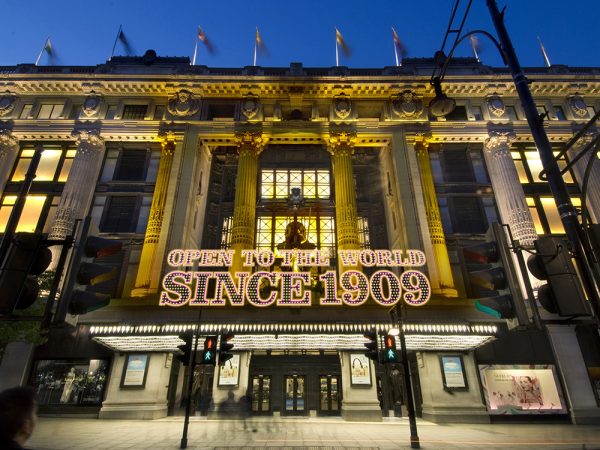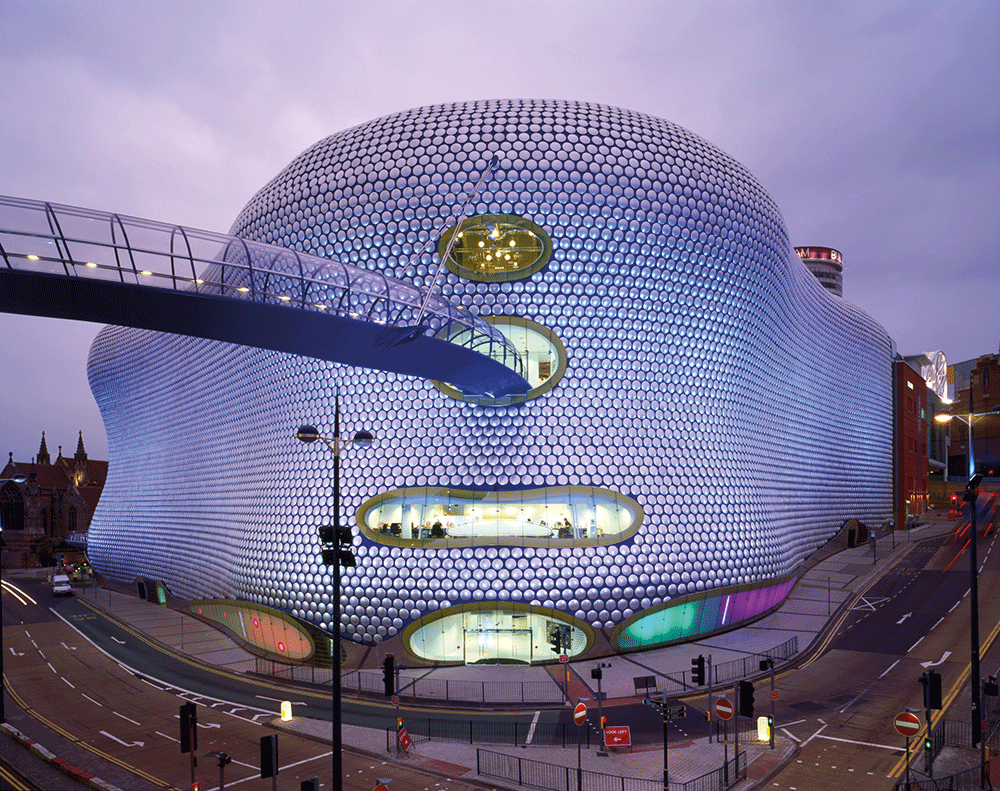Since opening in 1908, Selfridges & Co. has redefined luxury retail, blending avant-garde design with unparalleled customer experiences. This article explores its storied past, innovative strategies, sustainability efforts, and cultural influence, revealing how the brand remains a global retail trailblazer. Dive into the world of Selfridges, where commerce meets art and tradition intersects with modernity.
The Birth of a Retail Icon
In 1908, American retail visionary Harry Gordon Selfridge embarked on an audacious mission: to redefine shopping in Edwardian London. Having honed his craft at Chicago’s Marshall Field’s—a pioneer in modern retail—Selfridge recognized an opportunity to transplant his revolutionary ideas across the Atlantic. At a time when British department stores operated under Victorian-era formality, he envisioned a ‘palace of shopping’ that blended commerce with theater, democratizing luxury while elevating the act of shopping to a social event.
The Oxford Street store, which opened in March 1909 after two years of construction, was a marvel of both ambition and engineering. Designed by architect Daniel Burnham, its neoclassical façade—adorned with towering Ionic columns and vast plate-glass windows—declared its grandeur before a single customer stepped inside. The building’s steel frame allowed for unprecedented open-plan interiors, flooded with natural light from a central glass dome. Unlike the cramped, dimly lit emporiums of the era, Selfridges offered airy atriums, marble staircases, and a rooftop terrace featuring an ornamental garden and café. This architectural audacity transformed Oxford Street from a nondescript thoroughfare into London’s retail epicenter, a status it retains today.
Selfridge’s genius lay in understanding that a store could be both a marketplace and a destination. He introduced innovations that shattered Victorian retail conventions:
- Window displays as street theater: Prior to Selfridges, shop windows were cluttered storage spaces. Selfridge hired professional artists to create curated, ever-changing displays—a tactic that turned sidewalks into stages and passersby into audiences. His 1909 debut featured a biplane suspended above the entrance, capitalizing on aviation mania following Louis Blériot’s cross-Channel flight.
- Democratizing luxury: He abolished the era’s common practice of reserving premium goods for aristocratic clients, instead inviting all customers to handle merchandise. Price tags—a novelty at the time—eliminated haggling, while lenient return policies built trust.
- Retail as social space: The store’s lavish restrooms, writing rooms, and in-house post office catered to women, who increasingly shopped unchaperoned. By hosting suffrage rallies and art exhibitions, Selfridges became a hub for the era’s “New Woman,” blending commerce with cultural progressivism.
Central to this transformation was Selfridge’s mantra: “The customer is always right.” He trained staff to serve with deference rather than suspicion, a stark contrast to competitors where clerks shadowed shoppers. This philosophy extended to advertising—Selfridge spent £36,000 (equivalent to £4 million today) on pre-opening promotions, including full-page newspaper spreads declaring the store a “free museum” open to all, regardless of purchase intent.
The impact was immediate and seismic. On opening day, 90,000 visitors marveled at pneumatic tube systems whisking payments to cashiers, an in-store library, and a silent-room for overwhelmed patrons. Competitors dismissed it as a vulgar American import, but Selfridge’s blend of spectacle and accessibility resonated with a rapidly modernizing society. By 1924, the store had expanded to occupy an entire city block, its very name synonymous with retail innovation—a legacy that would set the stage for the even bolder experiments explored in the next chapter.
Crucially, Selfridge’s model redefined urban commerce as experiential rather than transactional. His store wasn’t merely a place to buy gloves or hats; it was where one went to see the future.
Pioneering Retail Innovations

Since its inception, Selfridges & Co. has consistently reinvented retail by blending commerce with spectacle, ensuring its dominance in an ever-changing market. While its founder Harry Gordon Selfridge established foundational concepts like window displays and in-store theatrics, the brand’s later innovations transformed these ideas into modern phenomena that redefine what a department store can be. From boundary-pushing visual merchandising to digital foresight, Selfridges’ strategies have kept it at the forefront of luxury retail.
The store’s theatrical window displays evolved from Selfridge’s original vision into a celebrated art form. By the mid-20th century, these installations became seasonal cultural events, employing avant-garde themes, kinetic sculptures, and multimedia elements. In 2012, the store collaborated with filmmaker Tim Burton for a Halloween display featuring macabre puppets and Gothic landscapes, merging cinema with retail. These windows don’t just showcase products—they ignite imagination, turning Oxford Street into an open-air gallery. Today, teams of artists and designers work year-round to craft narratives that reflect societal trends, from sustainability to gender fluidity, ensuring the windows remain provocative conversation starters.
When Selfridges launched its e-commerce platform, Selfridges.com, in 2000—years before competitors like Harrods went digital—it signaled a radical gamble. Skeptics questioned whether luxury shoppers would embrace online purchasing, but the store leaned into its flair for showmanship. The website debuted with immersive product storytelling, high-resolution imagery, and virtual consultations, mirroring the in-store experience. By 2014, the launch of a global shipping service expanded its clientele beyond London, capturing international markets. Crucially, the platform integrated with physical stores through click-and-collect services and exclusive online drops, creating a seamless omnichannel ecosystem. This digital pivot proved prescient: online sales surged during the COVID-19 pandemic, accounting for 40% of revenues by 2021.
The ‘Wonder Rooms’, unveiled in 2010, reimagined luxury retail as curated theater. Spanning 26,000 square feet, this dedicated space within the Oxford Street store houses rare watches, fine jewelry, and bespoke craftsmanship from brands like Fabergé and Rolex. Designed by architect David Chipperfield, the rooms feature velvet-lined alcoves, kinetic art installations, and interactive displays that evoke a sense of discovery. Sales associates, trained as storytellers, emphasize the heritage behind each piece, transforming transactions into emotional experiences. The concept doubled foot traffic in its first year and cemented Selfridges’ reputation as a destination for experiential luxury, not just transactions.
Pop-up shops and experiential activations further underscore Selfridges’ knack for blending commerce with culture. In 2018, the store partnered with sustainable fashion platform Vestiaire Collective for a month-long resale pop-up, challenging perceptions of secondhand luxury. The 2021 “SuperFutures” pop-up featured AI-generated art and wearable tech, positioning the brand at the intersection of innovation and style. Seasonal events, like rooftop skate parks or immersive champagne bars, create urgency and exclusivity, leveraging social media buzz to attract younger demographics. These ephemeral concepts also serve as testing grounds for emerging trends—such as rental fashion or digital avatars—that often evolve into permanent offerings.
By threading creativity through every facet of retail, Selfridges avoids the stagnation plaguing traditional department stores. Its willingness to experiment—whether through AI-driven personalization or collaborations with非传统艺术家—keeps the brand culturally resonant. As consumer expectations shift toward authenticity and engagement, these innovations provide a blueprint for blending heritage with relevance, ensuring Selfridges remains not just a retailer, but a cultural icon. This adaptive spirit now extends into its next frontier: redefining luxury through sustainability, a challenge as ambitious as any in its 115-year history.
Sustainability and Ethical Retailing

In an era where consumers increasingly demand accountability from the brands they support, Selfridges & Co. has positioned itself at the forefront of sustainable luxury through its ambitious Project Earth initiative. Launched in 2020, this multiyear plan seeks to redefine retail by embedding environmental and ethical considerations into every facet of the business. While the store’s earlier innovations—such as experiential retail and digital transformation—cemented its reputation as a market leader, Project Earth represents a bold pivot toward addressing the urgent challenges of climate change and resource depletion.
Central to the initiative is the goal of achieving net-zero carbon emissions by 2040, a target that exceeds the UK government’s own timeline by a decade. To meet this, Selfridges has implemented rigorous measures, including transitioning to 100% renewable electricity across all stores, optimizing logistics to reduce transport emissions, and collaborating with suppliers to minimize carbon footprints. By 2030, the retailer aims to ensure that 45% of transactions come from products meeting strict sustainability criteria, such as recycled materials or fair labor practices. These efforts are not without challenges: luxury retail, traditionally reliant on resource-intensive materials like leather and exotic textiles, must reconcile opulence with ecological responsibility. Selfridges addresses this by curating collections that prioritize innovation, such as lab-grown diamonds and plant-based alternatives to animal-derived fabrics.
A cornerstone of Project Earth is the push toward circularity. The Resellfridges program, launched in partnership with platforms like Vestiaire Collective and Reflaunt, allows customers to buy and sell pre-owned luxury items in-store and online. This initiative not only extends the lifecycle of high-end goods but also challenges the perception of luxury as disposable. Similarly, the store’s rental service for occasion wear and accessories—featuring brands like Gucci and Balenciaga—encourages a shift from ownership to access. Such programs underscore a broader industry trend, yet Selfridges distinguishes itself by integrating these services seamlessly into its luxury ecosystem, ensuring that sustainability aligns with—rather than compromises—the aspirational allure of its brand.
Collaborations with eco-conscious designers and brands further amplify this mission. Partnerships with pioneers like Stella McCartney, whose commitment to vegan materials and carbon-neutral operations is well-documented, allow Selfridges to showcase how sustainability can coexist with high fashion. The store also champions emerging labels, such as Bethany Williams and Phoebe English, which prioritize upcycled materials and ethical production. These alliances not only diversify the retailer’s offerings but also signal to the industry that environmental stewardship is a non-negotiable criterion for future success.
Educating consumers remains critical to driving systemic change. Campaigns like ‘Buy Better, Wear Longer’ leverage Selfridges’ cultural influence to reframe sustainability as a creative, empowering choice rather than a sacrifice. Through in-store workshops on garment care, collaborations with repair specialists like The Restory, and digital content highlighting sustainable styling tips, the retailer fosters a deeper connection between customers and their purchases. Window displays and pop-ups—historically used to dazzle with spectacle—now double as platforms for storytelling about material origins and artisan craftsmanship.
Yet, the tension between growth and sustainability persists. Critics argue that even eco-conscious retail relies on consumption, a paradox Selfridges navigates by emphasizing quality over quantity and transparency over tokenism. By publishing detailed progress reports and partnering with third-party auditors, the brand holds itself accountable while inviting customers to join its journey.
As the retail landscape evolves, Selfridges’ commitment to Project Earth reflects a broader vision: that luxury’s future lies not in excess, but in intentionality. By marrying its legacy of innovation with ethical imperatives, the store continues to redefine what it means to be a purpose-driven brand in the 21st century.
Cultural Impact Beyond Shopping

Since its inception, Selfridges & Co. has transcended its role as a mere retail destination, evolving into a dynamic cultural institution that shapes and reflects societal trends. While the previous chapter detailed its pioneering strides in sustainability, this chapter delves into how the store has become a canvas for artistic expression, a stage for avant-garde design, and a forum for provocative ideas—solidifying its position as a nexus where commerce, creativity, and public discourse intersect.
At the heart of this cultural ethos are its groundbreaking art installations, which transform the store into an immersive gallery. In 2022, Selfridges hosted Yayoi Kusama’s Infinity Rooms, a series of mirrored, kaleidoscopic environments that drew over 200,000 visitors. The installation turned the store’s Oxford Street location into a pilgrimage site for art enthusiasts, many of whom had never stepped inside a luxury department store. By democratizing access to Kusama’s work—often confined to elite museums—Selfridges redefined the relationship between retail spaces and contemporary art. Earlier collaborations, such as a 2015 partnership with Damien Hirst to display his ‘Entomology Cabinets’ alongside jewelry counters, further blurred the lines between commerce and curation, challenging visitors to reconsider the boundaries of consumerism.
Fashion, too, has been a vehicle for cultural commentary through Selfridges’ collaborations with designers who push societal norms. Its partnership with Vivienne Westwood in the 1990s exemplified this, as the store showcased her politically charged collections that critiqued consumer culture and environmental neglect—a bold move for a luxury retailer. Similarly, the 2013 ‘London Underground’ campaign with Alexander McQueen reimagined the store’s windows as a dystopian homage to British subcultures, merging fashion with street art and industrial design. These collaborations didn’t just sell products; they sparked conversations about identity, sustainability, and rebellion, positioning Selfridges as a platform for designers to amplify their ideological visions.
The annual Festival of Imagination, launched in 2018, epitomizes Selfridges’ ambition to fuse creativity with experiential innovation. The month-long event transforms the store into a hybrid of art fair, tech expo, and performance space. In 2021, the festival featured an AI-generated digital art installation by Refik Anadol, which visualized consumer data as swirling abstract landscapes, critiquing surveillance capitalism while mesmerizing audiences. Another highlight was the 2020 ‘Soundscape’ exhibit, where visitors navigated rooms filled with sonic sculptures by Björk and experimental composers, redefining retail spaces as multisensory environments. These initiatives attract not just shoppers but academics, tech innovators, and cultural critics, fostering interdisciplinary dialogue.
Selfridges’ cultural impact extends beyond physical spaces. Its ‘Buying Better’ editorial platform—though linked to sustainability—also serves as a think tank, publishing essays on topics like the ethics of AI in fashion and the resurgence of craft traditions. This intellectual rigor complements its visual spectacles, creating a holistic ecosystem where consumers are invited to engage critically with the forces shaping their world.
By embedding art, technology, and activism into its DNA, Selfridges has redefined what a department store can represent. It doesn’t just respond to cultural shifts—it anticipates and influences them, creating a feedback loop between consumer desire and creative innovation. As the next chapter explores its digital evolution, it’s clear that Selfridges’ ability to remain a cultural bellwether hinges on this same spirit of experimentation, ensuring its relevance in an era where consumers demand meaning as much as materialism.
The Future of Luxury Retail
Selfridges & Co.’s enduring relevance in luxury retail hinges on its ability to marry heritage with forward-thinking innovation. Amid the digital revolution and evolving consumer expectations, the brand is redefining what it means to be a luxury destination in the 21st century. Central to this transformation is its strategic embrace of technology, expansion of hybrid shopping models, and alignment with the values of younger generations—all while navigating challenges like fast fashion’s dominance and the demand for ethical consumption.
A cornerstone of Selfridges’ digital strategy is its investment in augmented reality (AR) and immersive virtual experiences. In 2021, the launch of its ‘Virtual Selfridges’ platform marked a bold step into digital-first luxury, offering 3D-rendered shopping environments inspired by its iconic Oxford Street store. Collaborations with AR startups like HoloMe enable customers to “try on” accessories or visualize art installations in their homes through smartphone apps, blending the tactile allure of luxury with digital convenience. The store has also experimented with virtual showrooms for niche designers, allowing global audiences to explore collections in interactive, gamified spaces. These efforts signal a shift from transactional e-commerce to experiential digital engagement—a critical differentiator in an era where consumers crave novelty and personalization.
Complementing this is the rapid expansion of its click-and-collect service, which has evolved beyond practicality into a curated brand experience. Luxury shoppers can now collect online orders at dedicated “Style Concierge” counters, where staff offer complimentary tailoring, gift-wrapping, or espresso bars for instant gratification. During peak seasons, exclusive product drops—think limited-edition Collaborations or pre-launch access to designer collections—are reserved for click-and-collect users, incentivizing offline visits while rewarding digital engagement. This hybrid model not only drives footfall but reinforces Selfridges’ role as a physical destination, even as online sales grow.
To secure its future, Selfridges is strategically courting Gen Z, a demographic prioritizing sustainability and self-expression. Partnerships with youth-centric brands like Telfar, Collina Strada, and Ahluwalia reflect this shift, emphasizing bold aesthetics and eco-conscious materials. The retailer’s ‘Resellfridges’ initiative—a peer-to-peer marketplace for pre-owned luxury goods—taps into Gen Z’s circular economy values, while pop-ups like 2023’s “Unlimited” showcase, featuring gender-neutral streetwear and digital art installations, blur the lines between retail and cultural activism. Social media remains pivotal: TikTok campaigns showcasing behind-the-scenes design processes or #haul videos shot in-store mirrors create relatable, shareable content that positions Selfridges as both aspirational and accessible.
Yet challenges loom. Fast fashion’s relentless pace and affordability threaten to overshadow luxury’s slower craftsmanship cycle. Selfridges counters this by doubling down on storytelling, highlighting artisanship through maker documentaries and in-store workshops that humanize the value of high-end goods. Meanwhile, its Project Earth sustainability pledge—aiming for net-zero carbon and materials circularity by 2030—addresses shifting consumer ethics. Initiatives like banning exotic skins and introducing “carbon-neutral” product tags cater to eco-aware shoppers without compromising luxury’s exclusivity.
Balancing legacy with innovation remains delicate. While AR and Gen Z marketing propel the brand forward, Selfridges ensures foundational elements—the theatrical window displays, personalized shopping services, and commitment to experiential retail—stay central. By integrating digital fluency with timeless allure, the retailer positions itself not just as a survivor of retail’s upheavals, but as a pioneer crafting the future of luxury on its own terms.
Conclusions
From its ornate Edwardian origins to its bold sustainability pledges, Selfridges & Co. exemplifies how retail can blend commerce with artistry and responsibility. As it navigates digital transformation and ethical challenges, the store remains a benchmark for innovation. For shoppers and historians alike, Selfridges isn’t just a destination—it’s a living narrative of retail’s past, present, and future.

















